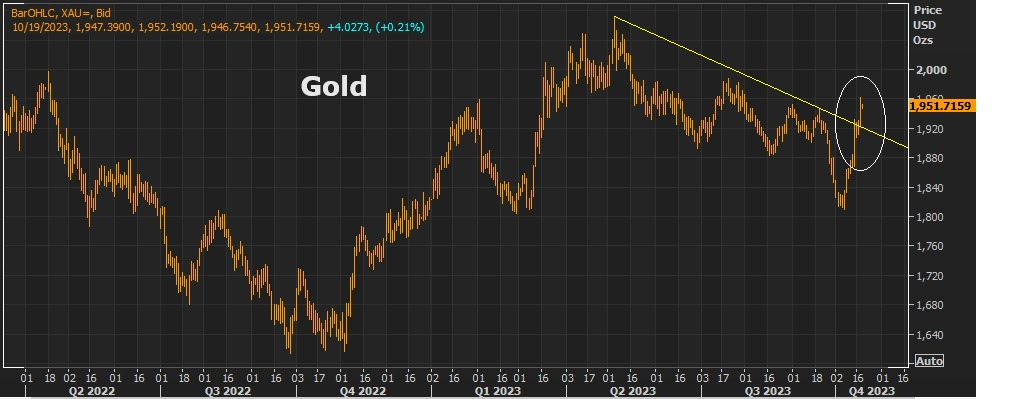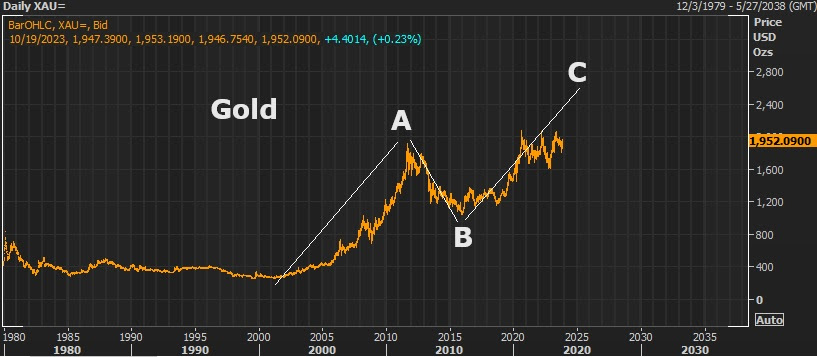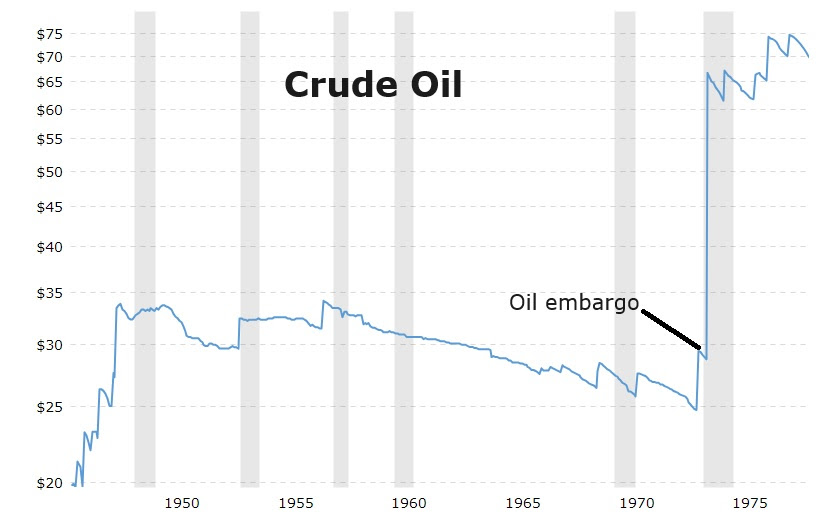|
|
|
|
|
|
 |
|
Please add bryan@newsletter. |
| October 19, 2023
Jerome Powell spoke today at the Economic Club of New York. For some context, below is what has happened in the interest rate market since the Fed’s September 20th meeting, where they maintained the forecast for another quarter point HIKE this year, and removed two rate CUTS from their forecast for next year.  As you can see, that Fed meeting was the lift-off catalyst for the 10-year yield, to the tune of 64 basis points. This rise in yields has taken stocks down as much as 5%. It’s pushed mortgage rates to new 23-year highs. And it forced the Bank of Japan back into the currency markets to defend the value of the yen on October 3rd. With that, coming into today’s commentary from Powell, we should have expected him to talk about the tightening of financial conditions that has taken place in the interest rate market. Indeed, near the bottom of his prepared remarks, there it is: “Financial conditions have tightened significantly in recent months, and longer-term bond yields have been an important driving factor in this tightening. We remain attentive to these developments because persistent changes in financial conditions can have implications for the path of monetary policy.” That’s the market doing the work for the Fed, which should make it very clear that the Fed has nothing more to do (in this tightening cycle), unless inflation ramps again. That said, in the Q&A, he did say that he did NOT think policy was too tight right now. That sent stocks lower, and 10 year yields up. That’s a perplexing statement. But there was a lot of conversation that lacked measure, in the Q&A. He also said that perhaps the rise in the interest rate market is the market recalibrating to the view of “economic resilience.” If that’s the case, the inverted yield curve, which was reflecting a view of recession, should de-invert (to reflect growth, confidence and a healthier economy, i.e. lower short-term rates and higher long-term rates). And maybe it will. We may have a clue in the way the market closed today. While the 10-year yield rose to 5%, the 2-year yield reversed on the day, closed lower, and put in a technical reversal signal (an outside day).
|
 |
|
Please add bryan@newsletter. |
| October 18, 2023
Last Friday, we talked about the potential for another 1973-like oil embargo. This morning, OPEC-member Iran called for just that, sanctioning Israel –which would likely, quickly, be imposed on those countries supporting Israel. It was dismissed in the media by other OPEC members. But by the day’s end the U.S. Treasury was relaxing sanctions against Venezuela (which is an OPEC member), freeing up access to Venezuelan oil, gas and gold. We looked at the gold chart yesterday, which had another big day today, breaking out of this cyclical downtrend.  There has fundamentally been a greenlight to buy gold for some time, given the explicit (global) policies to inflate asset prices and inflate away unsustainable sovereign debt. It’s the historic inflation hedge, yet it has been among the worst performing asset class over the past three years. Since the first, massive, covid policy-response in March of 2020, stocks (S&P 500) are up over 80%, oil is up four-fold, copper is up 90% and real estate (the Case-Shiller Home Price Index) is up 44%. Gold is up just 25%. And yet, central banks bought gold in record amounts last year. Has there been manipulation in the gold market? Price suppression? Or is it Bitcoin? Did Bitcoin supplant gold as the favored hedge against inflation and money printing profligacy? Indeed, the price has jumped multiples over the past three years. But I suspect in a march toward global war (as it appears), people want gold over bitcoin. With that, we’ve often looked at this longer-term chart of gold over the years.
 This is a classic C-wave (from Elliott Wave theory). This technical pattern projects a move up to $2,700ish. The price of gold has continued to make progress along that path. How do you play it? Get leveraged exposure to gold through gold miners, or track the price of gold through an ETF, like GLD. Full disclosure, we are long gold miners, including Barrick Gold in our Billionaire’s Portfolio.
|
 |
|
Please add bryan@newsletter. |
| October 17, 2023
Retail sales came in stronger than expected this morning. That sent yields higher on the day, and nudged expectations of another Fed move a touch higher. But with the Middle East situation continuing to escalate, there are clues that it will become a global war. And with that, my bet is that the next move by the Fed will be a cut. Among the (global war escalation) clues, the way gold behaved this past Friday…  As you can see in this chart above, Friday’s 3.4% move in gold puts it in company with some major event-risk days of the past twenty-plus years.  And as you can see, we now have this technical breakout in gold. A retest of the record highs looks very likely. |
 |
|
Please add bryan@newsletter. |
| October 16, 2023
We kicked off Q3 earnings season Friday with the big banks. As we’ve discussed, these earnings reports come from a period during which the economy was hot, growing at about a 5% annualized quarterly growth rate. And yet, FactSet shows Wall Street estimates are still looking for a 0.3% decline in S&P 500 earnings. Again, that sets up for positive surprises, which tends to be good for stocks. And we’re seeing it early on, in the reporting from three of the big four banks. All three beat on earnings and revenues. The average year-over-year growth for JPM, Wells Fargo and Citi was 18% earnings growth on 13% revenue growth. These are big tech-like growth numbers, but trading at an average valuation of just 8 times earnings (trailing P/E). That’s less than half the market P/E. And remember, all of the big banks have spent most of the past three years manufacturing down earnings, by setting aside billions of dollars in allowances for loan losses. Yet when the risk of loan loss rises, they’ve been backstopped by the Fed (de-risked) and incentivized to fuel credit creation to help the economy — from which they make money in loan origination, investment banking and trading. When times are more stable, their customer account balances balloon, from which they get to earn an interest rate spread from the rising interest rate environment. The big banks continue to prove (thanks to policymaker manipulation) that they are “heads they win, tails they win” businesses. With all of the above in mind, the contraction in S&P 500 earnings, of the past several quarters, should be behind us. The analyst community’s consensus on Q4 earnings is expected to be 7.6% growth (yoy). And for next year (full year), they are looking for a return to double-digit earnings growth (12% growth, yoy). With that outlook, the bottom-up target price for the S&P 500 over the next twelve months is 5,115. That’s 17% higher than today’s close. Add to this, both the market and Fed are projecting lower yields by this time next year, to the tune of more than 50 basis points. That means bonds are a buy. So, this brings us back to my note from last month on the 60/40 portfolio (Wall Street’s trusty 60% equities/40% bond allocation). Remember, this 60/40 portfolio finished down 18% last year. And both stocks and bonds contributed to the negative return — both were down on the year. That’s only happened four times since 1928. Each of those four times in history (1931, 1941, 1969 and 2018), bonds finished up the following year (total return). This time, with two and a half months remaining in the year, bond investors are still down (ytd). What’s the point? UBS had a note out today saying they think stocks, bonds and cash will produce positive returns through the middle of next year. The backdrop we’ve discussed above would align with that view. What would global war look like for these two key asset classes? Below are returns when wartime spending kicked in, during World War 2 …  Stocks averaged 25% a year. Bonds averaged 2.8%. On the latter, remember, the Fed capped interest rates at low levels (yield curve control) to finance war debt. |
 |
|
Please add bryan@newsletter. |
| October 13, 2023
The Yom Kippur War started on October 6, 1973. It began by a surprise attack on Israel by Egypt and Syria. Almost 50 years to the day (50 years and one day), Hamas launched a surprise attack on Israel (last Saturday). The similarities to that period don’t stop there. In 1973, U.S. inflation was hot at the time. The U.S. President was facing the threat of impeachment. And U.S. superpower status was being challenged by the Soviets (now by China). What happened days into the Yom Kippur War? An oil embargo. As leverage against the Western world’s support for Israel (namely, the United States’ support), OPEC banned the sale of oil to Western countries. Oil prices did this …  Will this history rhyme? Keep in mind, over the past eight years, the Western world has explicitly colluded to kill fossil fuels, which is the historic life blood of OPEC member economies. With that, as we’ve discussed here in my daily notes, we already have this dividing line from the global climate agenda, where the Western world’s war on fossil fuels has pushed Middle East, Russia and China closer together. The dividing line between the Western world and OPEC is now more clear, with the events of the past week. Could we see a retaliatory oil embargo? |